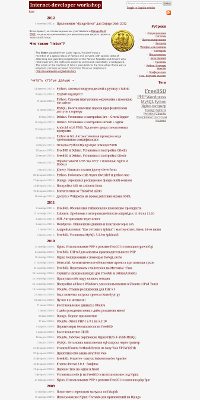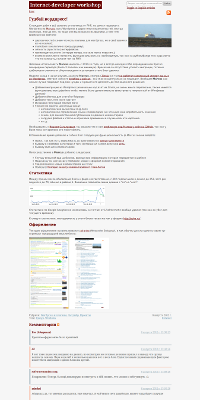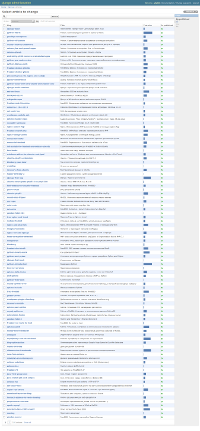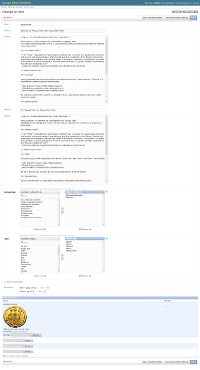Bilingual blog on Django
Project description
Introduction
Marcus is billingual blog engine, written Ivan Sagalaev (http://softwaremaniacs.org/about/).
This fork over augmented and has the following features:
Billingual articles, Categories, Tags and Comments
Simple file uploader for the article with a preview images
Archive and date navigation
Pingback
Automatically pings search engines on new entries
Supports markdown (http://pypi.python.org/pypi/markdown2)
Comments have CSRF protection via JavaScript, supported Akismet (antispam service)
There are authentication via OpenID, or by login with pre-moderated
There is support for retweet button
Sitemaps for articles, feeds for articles and comments
A simple search module
A pretty minimalistic theme
Import from Wordpress (command “wordpress_importer”)
Examples
http://softwaremaniacs.org/blog/ (Ivan Sagalaev)
https://prudnitskiy.pro/ (Pavel Rudnitskiy)
http://adw0rd.com/ (Mikhail Andreev)
About marcus
Screenshots:




Installation
http://pypi.python.org/pypi/django-marcus
mkvirtualenv marcus pip install --process-dependency-links django-marcus # use "--process-dependency-links" for pip>=1.5 django-admin.py startproject <project_name>
Configuration
Add to settings.py:
import os
import imp
PROJECT_ROOT = os.path.dirname(__file__)
PROJECT_NAME = os.path.basename(PROJECT_ROOT)
STORAGE_ROOT = os.path.join('/storage', PROJECT_NAME)
LOCALE_PATHS = (
os.path.join(imp.find_module('marcus')[1], 'locale'),
)
ADMINS = (
('Admin', 'admin@example.com'),
)
// Please setup settings.MANAGERS for notify about new comments
MANAGERS = ADMINS
MARCUS_PAGINATE_BY = 20
MARCUS_ARTICLES_ON_INDEX = 10
MARCUS_COMMENTS_ON_INDEX = 10
MARCUS_COMMENT_EXCERPTS_ON_INDEX = 2
MARCUS_ITEMS_IN_FEED = 20
MARCUS_AUTHOR_ID = 1
MARCUS_TAG_MINIMUM_ARTICLES = 0
# Specify blog names:
from django.utils.translation import ugettext_lazy as _
MARCUS_TITLE = _('Blog')
MARCUS_SUBTITLE = _('Sample blog')
MARCUS_DESCRIPTION = _('')
MARCUS_KEYWORDS = _('')
# You can specify extras for markdown:
MARCUS_MARKDOWN_EXTRAS = ['code-friendly', 'wiki-tables']
# You can specify #hashtag or @name as suffix for Twitter:
MARCUS_RETWEET_SUFFIX = "#marcus"
# Specify a fields which will used in search:
MARCUS_SEARCH_FIELDS = [
'slug', 'title_ru', 'title_en', 'text_ru', 'text_en',
'categories__slug', 'categories__title_ru', 'categories__title_en',
]
# OpenID sessions dir. OpenID authentication will not work without it.
SCIPIO_STORE_ROOT = os.path.join(STORAGE_ROOT, 'scipio')
# URL passed to OpenID-provider to identify site that requests authentication.
# Should not end with '/'.
# Complete site URL is passed if the value is empty.
SCIPIO_TRUST_URL = ''
# Akismet is a spam filtering service.
# Without the key will not work comments.
# You can receive the key here https://akismet.com/signup/
SCIPIO_AKISMET_KEY = ''
SCIPIO_USE_CONTRIB_SITES = True
AUTHENTICATION_BACKENDS = (
'scipio.authentication.OpenIdBackend',
'django.contrib.auth.backends.ModelBackend',
)
TEMPLATE_CONTEXT_PROCESSORS = (
'django.contrib.auth.context_processors.auth',
'django.core.context_processors.request',
'marcus.context_processors.marcus_context',
)
MEDIA_ROOT = os.path.join(STORAGE_ROOT, 'media')
MEDIA_URL = '/media/'
STATIC_ROOT = os.path.join(STORAGE_ROOT, 'static')
STATIC_URL = '/static/'
INSTALLED_APPS = (
'django.contrib.auth',
'django.contrib.admin',
'django.contrib.admindocs',
'django.contrib.contenttypes',
'django.contrib.sessions',
'django.contrib.sites',
'django.contrib.messages',
'django.contrib.staticfiles',
'django.contrib.flatpages',
'marcus',
'scipio',
)
Add to urls.py:
from django.conf.urls import patterns, include, url
from django.contrib.staticfiles.urls import staticfiles_urlpatterns
from django.contrib import admin
admin.autodiscover()
urlpatterns = patterns('',
url(r'^admin/doc/', include('django.contrib.admindocs.urls')),
url(r'^admin/', include(admin.site.urls)),
url(r'^', include('marcus.urls')),
)
urlpatterns += staticfiles_urlpatterns()
And run so:
python ./manage.py runserver 8000
After installation, going to http://localhost:8000/admin/scipio/profile/ and create you profile.
Wordpress importer settings:
Marcus includes “wordpress_importer” it is command that imports your entries from the Wordpress to the Marcus. It has a built-in pipelines for additional filtering data.
MARCUS_WORDPRESS_IMPORTER = {
'ARTICLE_PIPELINES': (
'marcus.wordpress_importer.pipelines.CodecolorerToHighlightJsPipeline',
'marcus.wordpress_importer.pipelines.WpContentUploadsToMediaPipeline',
'marcus.wordpress_importer.pipelines.BbCodeDetector',
'marcus.wordpress_importer.pipelines.EscapeTheUnderscore',
# 'marcus.wordpress_importer.pipelines.ChangeUrlToArticleForImagePipeline',
# 'marcus.wordpress_importer.pipelines.RemoveImgClassPipeline',
# 'marcus.wordpress_importer.pipelines.HtmlToMarkdownPipeline',
),
# 'CATEGORY_PIPELINES': tuple(),
# 'TAG_PIPELINES': tuple(),
'COMMENT_PIPELINES': (
'marcus.wordpress_importer.pipelines.CodecolorerToHighlightJsPipeline',
),
'ALLOW_DOMAINS': ( # Used to determine the internal domain to import only local "wp-content/uploads", etc.
'my-old-blog-on-wordpress.org',
'www.my-old-blog-on-wordpress.org',
),
}
How enable WYSIWYG?
As an editor was selected MarkitUp (http://markitup.jaysalvat.com/), so you need to install django-markitup:
pip install django-markitup
Now, add to your settings.py:
INSTALLED_APPS = (
...
'markitup',
)
MARKITUP_FILTER = ('markdown2.markdown', {'safe_mode': True})
MARKITUP_SET = 'marcus/sets/markdown'
And add to your urls.py:
url(r'^markitup/', include('markitup.urls')),
That’s all!
Installation guide for new projects:
django-admin.py startproject project cd project pip install --process-dependency-links django-marcus # use "--process-dependency-links" for pip>=1.5 ... Copy the settings to settings.py and you urls to you urls.py described above ... python ./manage.py syncdb python ./manage.py createsuperuser python ./manage.py runserver 8000
Go to https://akismet.com/signup/, get a key and enter it here:
SCIPIO_AKISMET_KEY = '<key>'
After installation, going to http://localhost:8000/admin/scipio/profile/ and create you profile.
MySQL Timezone Fixes
If you use MySQL and have problem with open an article by URL, it is likely that you did not work CONVERT_TZ, it can be solved as follows:
mysql_tzinfo_to_sql /usr/share/zoneinfo | mysql -u root -p mysql
License
BSD licensed.
Project details
Release history Release notifications | RSS feed
Download files
Download the file for your platform. If you're not sure which to choose, learn more about installing packages.
Source Distribution
File details
Details for the file django-marcus-0.7.5.tar.gz.
File metadata
- Download URL: django-marcus-0.7.5.tar.gz
- Upload date:
- Size: 176.1 kB
- Tags: Source
- Uploaded using Trusted Publishing? No
- Uploaded via: Python-urllib/2.7
File hashes
| Algorithm | Hash digest | |
|---|---|---|
| SHA256 |
8dc740f672f376b9f5b3937f7ed5e6690c69f1c05745f0b7d35f43a794a408bc
|
|
| MD5 |
de56154f0abe0c1f0b569d725e374af8
|
|
| BLAKE2b-256 |
92b7dd893312a55f4969c0744bae6590733fef949d28adb4789076cad0ca9dc0
|










